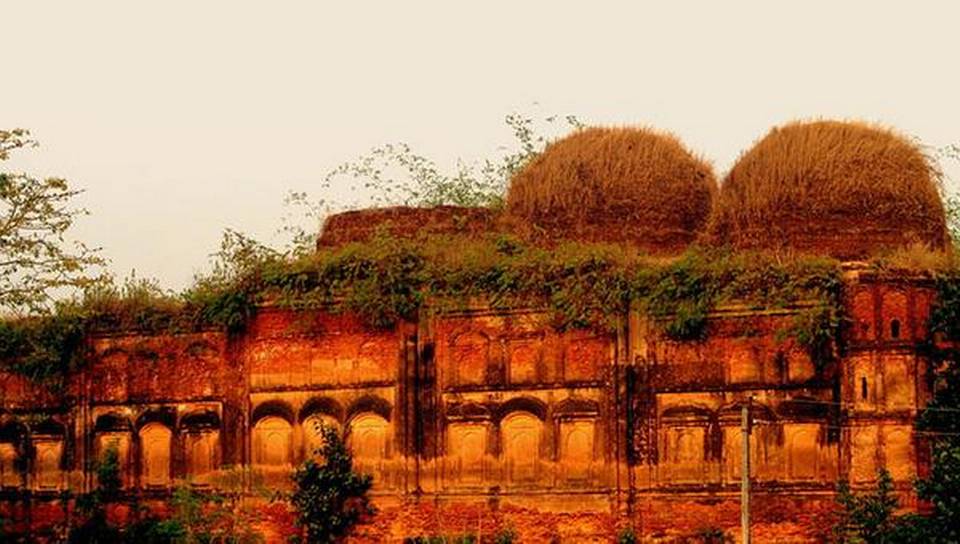Murshidabad, WEST BENGAL :
A journey through the ruins of Phuti Masjid, built by Sarfaraz Khan, in Murshidabad
It is difficult to imagine that Murshidabad, now a small, sleepy town in West Bengal, was among the richest courts of the 18th and 19th century. It hides many conspiracies, power brokers, pawns and fallen emperors in its heart.
One such fallen emperor was Sarfaraz Khan, the maternal grandson of Murshid Quli Khan, the founder of the city and the Nasiri dynasty. Nawab Murshid Quli Khan appointed Sarfaraz Khan as his successor before his death in 1727 as there was no direct heir to the throne. However, his son-in-law (Sarfaraz’s father) Shuja Khan frustrated Sarfaraz’s dreams. He felt that he had a bigger claim to the musnad, or the throne, of Murshidabad. Sarfaraz could only ascend the throne in 1739 with the title Alauddin Haider Jung.
A short-lived reign
But his problems did not stop there. The newly crowned Nawab fell out with his Wazir, Haji Ahmed. The Wazir won over the rich banker Jagat Seth Fateh Chand and Rai Rayan Chand and started plotting against the Nawab. Haji Ahmed invited Ali Vardi Khan, the Nawab Nazim of Bihar, to seek someone from the Mughal empire to replace Sarfaraz Khan. In the battle of Giria, Ali Vardi Khan defeated Sarfaraz Khan. The Musnad of Murshidabad, compiled by Purna Chandra Majumdar, mentions that the Jagat Seths suborned the Nawab’s men to place bricks and clods instead of cannon balls and fodder in Sarfaraz Khan’s magazine. Though the Nawab found out and gave charge of his artillery to a Portuguese, he was killed by a bullet as he rode out to battle on his elephant. Nawab Sarfaraz Khan ruled only for a year.
Inside Phuti Masjid
When I went to Murshidabad, I visited the grand mosques, palaces and imambaras constructed by the Nawabs who ruled for a longer time and in happier circumstances. But it was the Phuti Masjid that I found fascinating.
The mosque is quite large: 135 ft. long and 38 ft. wide with four cupolas at the corners. Only two of its five planned domes were completed. Dangerous looking spiral staircases lead up to the cupolas. As the builder died soon after construction began, the mosque was never completed. And so the name Phuti Masjid, or broken mosque. It is also known rather morbidly as Fouti Masjid. ‘Fout’ means death, and the name was apparently given after the builder’s death.
As I approached the mosque, I first saw brick walls surrounded by small cottages and fields on a dusty road. The walls were covered with moss. I went eastward, which is the direction in which people generally enter mosques. But I found to my dismay that the entrance was at a height and there were no steps leading up to it. My guide was young and he quickly climbed up. With his help, I somehow managed to scramble up the mud incline. I am glad that I did, for I immediately saw a huge hall and soaring arches. There was a sense of desolation, mystery and a strange undercurrent of spirituality in the mosque. An extremely religious and devout Nawab with money, power and resources had wanted to build a house of worship, yet no one ever prayed there. It was more like a scene from a horror movie: there was a semi-open roof, wild undergrowth, and trees and the sun rays peeped in through apertures. Just then I heard shrill voices. Two children from a nearby cottage, aged four and five, had clambered up to ask if they could be my guides!
One legend goes that this mosque was built in one night by Sarfaraz Khan. Another says that a number of workers toiled for several months to construct it. During roll call one day, it was found that one worker was not present. This happened a number of times and as the story became famous, the mysterious workman disappeared leaving his work incomplete and no one could match his skill. Both stories point to the hand of Djinns. Whatever be the truth, this broken structure is still standing despite all the odds, surrounded by houses, fields and hostile elements, a mute testimony to broken dreams.
source: http://www.thehindu.com / The Hindu / Home> Opinion> Columns – Where Stones Speak / by Rana Safvi / January 06th, 2019









